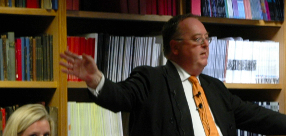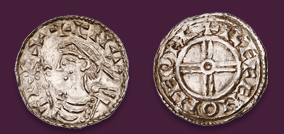
Auction: 8004 - An Important Collection of Renaissance Medals & Plaquettes
Lot: 4
Florentine School, 15th century Diomedes and Ulysses, oval bronze plaquette, 27.5mm. x 33.5mm., a scratch above Diomedes, early cast, brown patina, small ring for suspension, number in ink on reverse Diomedes, seated at left on an altar adorned with a garland, naked but for a chlamis over his left shoulder and arm, holding a short sword in his right hand, and the Palladium in his extended left hand, facing Ulysses, bearded and naked but for rags wrapped around his left arm, who stands before him, holding a sword in his left hand and gesturing towards the corpse of a priestess at his feet, between them a column surmounted by a statue (Neptune?) and behind them, walls and roof, During the siege of Troy Ulysses discovers the secret of the Palladium, the sacred statue which protects the city, and enlists Helen´s help in locating it. He and Diomedes plan to enter the city by night, make their way to the temple, kill the priestess, and steal the Palladium. The classical prototype for this scarce plaquette is an antique gem, known as the ´Felix Gem´ formerly in the collection formed in the 17th century by Thomas Howard, 2nd Earl of Arundel (1585-1646), and subsequently in the large and famous collection of engraved gems formed by the 4th Duke of Marlborough. The Marlborough collection was sold en bloc in 1875 to the collector David Bromilow, and the collection was dispersed at Christie´s in London, 20 June 1899, for a total of £34,762. The Diomedes and Ulysses gem, ´An intaglio on a deep coloured sard, representing Diomed and Ulysses seizing the Palladium, a work probably of the age of Hadrian´, realised £185. It is now in the Ashmolean Museum, Oxford. In ´Thoughts on the Cameos and Intaglios of Antiquity suggested by a short survey of the Blenheim Collection by a Lover of the Fine Arts´ Oxford, 1847, the Marlborough gem is described thus: ´Again in that wonderful work of the glyptic art, one of the first gems in the Marlborough collection and which (like that of Cupid and Psyche) was brought from Italy about 1631 by that Earl Arundel who was the father and founder of virtu in this country, Diomede is again the subject, but indeed not as before, as if the hero were in the act of defending his prize against some unseen assailant, but here Ulysses himself is introduced in angry remonstrance with Diomedes and (agreeably to the story told by Suidas) prepared to strike and rob him of his booty´. In the list of gems which follows, no.39 is described thus: ´Diomede´s dispute with Ulysses about his right to keep the Palladium, which he holds in his right hand and a dagger in his left to defend it; the body of a slain priestess lies at his feet. In the distance the statue of Neptune and the walls of Troy (Aeneid ii, 164, also Suidas suv voc.), By Felix who in this gem has improved on the manner in which other engravers have treated this subject.´ A sardonyx intaglio depicting Pallas Athena as the Palladium with this scene on its base, was in the collection of Lorenzo de Medici, and is now in the Uffizi Gallery. Some versions of this plaquette have a Greek inscription on the altar, ´Felix epoiese´ (Felix made this), the signature of Felix, possibly the engraver of the original gem. Felix may be the gem cutter listed in the inscription found in the Via Sacra in the centre of Rome, the author of several signed works. (´Felix, freedman of Calpurnius Severus´, in the list of gem engravers in ´Antique Gems´, by Charles William King, London, 1860). Also in Greek, above the head of Diomedes, can be seen the name of Calpurnius Severus. It is likely that Calpurnius Severus was a prominent Roman in the early first century. If he commissioned the work he was certainly familiar with Virgil´s Aeneid. References Bange 1922, 145; Cott p.143; Molinier 32; Planiscig, 1919, 254; Ricci, ii, pl.37, no.38; For gems: Gori, Museum Florentinum II pl.28, no.1 (Renaissance copy in cornelian); Paris, Cabinet des Médailles, Babelon 151 (a cameo of the same subject); A. Furtwängler, plate XLIX, 4. Estimate £ 300-500
Sold for
£240




